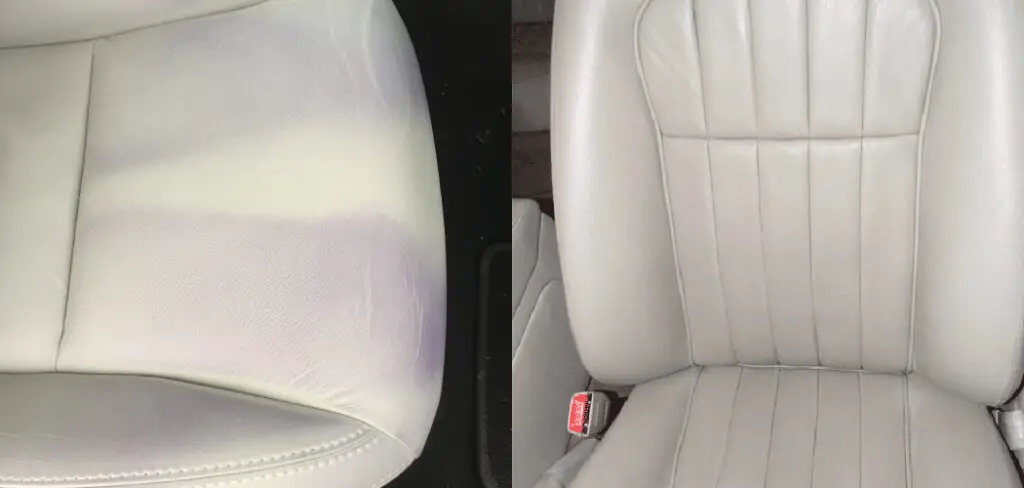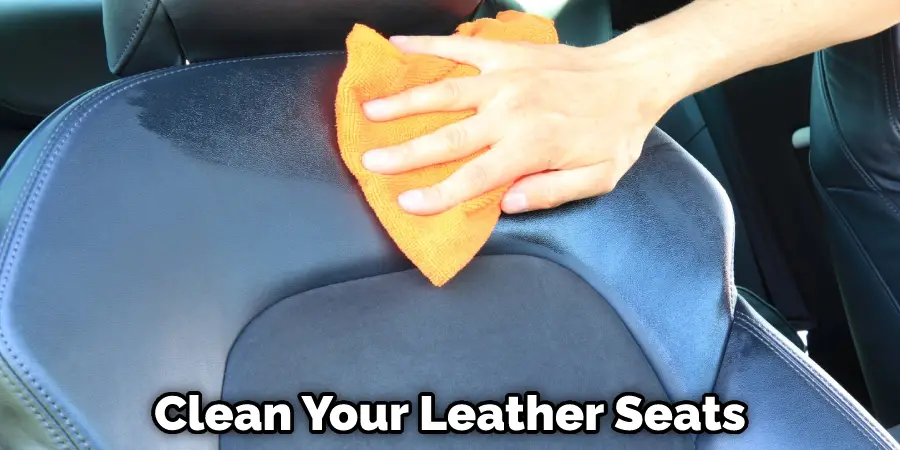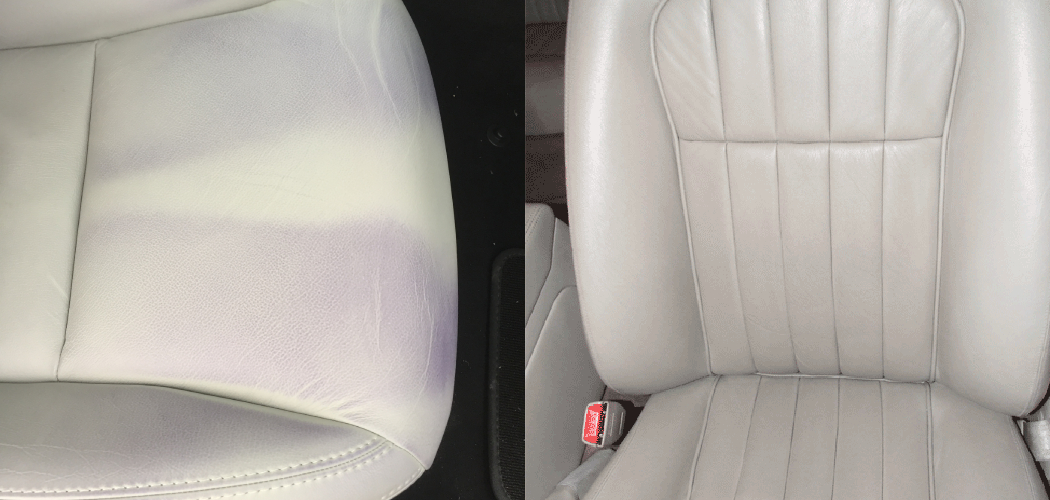If you’re like most people, your car is an important part of your life. Not only does it get you from point A to point B, but it’s also a reflection of your personal style. So why not make it look as good as it can? One way to do that is by dyeing your leather car seats.

It’s a process that’s not too difficult and can add a lot of personality to your vehicle. This blog post will give you all the information you need on how to dye leather car seats yourself. So whether you’re looking to change the color of your seats for aesthetic reasons or because they’ve seen better days, keep reading for tips and instructions!
Why Do You Need to Dye Leather Car Seats?
It is not uncommon for leather car seats to suffer from wear and tear. The sun can cause the leather to fade and crack, while spills can leave permanent stains. Dyeing your leather car seats is a great way to restore their look and protect them from further damage.
If you want to dye your leather car seats, there are a few things you need to know. In this article, we will take a look at how to dye leather car seats, what type of dye to use, and how to prepare the leather for dying. We will also provide some tips on how to get the best results. So be sure to read this full blog post.
What Type of Dye Should You Use?
You need to ensure you use the right type of dye when it comes to dyeing leather car seats. This is because not all dyes are created equal; some may damage the leather if used improperly. The best type of dye to use is aniline dye. This dye penetrates the leather, allowing it to hold onto the color better.
It also produces a natural look that won’t rub off easily. You can still use aniline dye if your car seats are made of synthetic leather. However, you may need to use a primer beforehand to help the dye adhere to the fabric. Make sure the primer is compatible with your dye to avoid any damage. If your car seats are made of genuine leather, there’s no need to use a primer.
Required Materials and Supplies
- Leather dye
- Clean, lint-free rags
- Rubbing alcohol
- Masking tape
- Temporary adhesive remover
- Sponge brush
- Soft cloths
- Hairdryer
Instructions: How to Dye Leather Car Seats
Step 1: Clean the Leather Seats.

The first step is to clean your leather seats. You need to remove all the dirt, dust, and debris that has accumulated on them. The best way to do this is to use a vacuum cleaner with a soft brush attachment. If there are any stubborn stains, you can spot-clean them with a mild soap and water solution. Once you’re done cleaning, make sure to dry the seats completely.
Step 2: Fill Any Remaining Cracks.
If your leather seats have cracks, you need to fill them in before dyeing. Otherwise, the dye will settle into the cracks and create an uneven finish. You can use a leather filler or repair kit for this step. Just follow the instructions on the packaging. If you don’t have any filler, you can also use a mixture of one part white vinegar and two parts linseed oil.
Step 3: Apply Rubbing Alcohol to the Seats.
The next step is to apply to rub alcohol on the seats. This will help the dye adhere to the leather better. Use a clean, lint-free rag and soak it in rubbing alcohol. Then, go over the entire seat surface, ensuring to get into all the nooks and crannies. You can skip this step if your leather seats are made of synthetic leather.
Step 4: Tape Off Any Areas You Don’t Want Dyed.
Now you need to tape off any areas you don’t want to be dyed. This includes the car’s floor mats, console, and door panels. You can use masking tape or painter’s tape for this. Make sure the tape is firmly attached, so the dye doesn’t bleed. This is important because dyeing leather is a messy process. So when you’re done taping, cover any areas you don’t want to get dirty.
Step 5: Apply the Dye to the Seats.

Now it’s time to apply the dye to the seats. You can use a sponge brush, paintbrush, or spray bottle. If you’re using a brush, dip it into the dye and then apply it to the seat in a back-and-forth motion. If you’re using a spray bottle, hold it about 6 inches away from the seat and evenly spray the dye onto the surface. Make sure to cover the entire seat, including any cracks or crevices.
Step 6: Let the Dye Dry.
Once you’ve applied the dye, let it dry for at least 24 hours. If possible, try to keep the area warm and humid during this time. This will help the dye set better. You can use a hair dryer on a low setting if you need to speed up the drying process. This is important because if the leather gets too dry, it can crack, and the dye won’t adhere.
Step 7: Apply a Conditioner.
After the dye has had a chance to dry, you’ll want to apply a conditioner to help keep the leather soft and flexible. You can find leather conditioners at most auto parts stores. Apply a small amount to a clean cloth and rub it into the leather. When applying the conditioner, ensure you don’t get any on the stitching.
Step 8: Enjoy Your New Look!
Once you’ve finished dying your leather car seats, you can sit back and enjoy the new look of your vehicle. Just make sure to keep up with the maintenance, and you’ll be able to enjoy your new seats for years to come! If your seats look dull, you can always add another coat of dye to brighten them up. Just remember to follow all of the steps carefully, and you’ll be able to achieve excellent results.
Now that you know how to dye leather car seats, you can give your vehicle a new look. You need to maintain your seats properly to keep them looking their best. Below are some tips for caring for your newly dyed leather car seats.

Additional Tips and Advice to Maintain Your Leather Car Seats:
- Wipe up spills immediately to prevent staining.
- Regular leather conditioner to keep the leather soft and supple.
- Avoid exposing the leather to direct sunlight or extreme heat, which can cause drying and cracking.
- Periodically vacuum the seats to remove dirt and debris.
- Have your seats professionally cleaned every few years to maintain their appearance.
- If you want to change the color of your leather seats, seek a professional upholstery shop specializing in this type of work.
With proper care, your leather car seats can last for many years. Following the tips above can keep them looking great and help extend their lifespan.
How Often Should You Dye Leather Car Seats?
It is advisable to dye your leather car seats every 6 to 12 months, depending on how often they are used. If you have light-colored leather seats, you may need to dye them more often to prevent them from looking dirty. When dying your leather car seats, use a good quality leather dye that will not damage the leather.
If your car seats start to look dull or faded, it may be time to give them a new lease on life with a fresh coat of dye. Dying leather car seats is not as difficult as it may seem and can help revive your car’s interior. In this post, we’ve provided instructions on cleaning leather car seats. So be sure to check them for everything you need to know about dying leather car seats!

How Long Does Leather Dye Last?
Leather is a natural product, and as such, it is subject to wear and tear. The lifespan of a leather car seat can be extended by regularly cleaning and conditioning the leather. However, even with proper care, leather will eventually show signs of age and wear.
One way to help mask these signs of aging is to dye the leather. The leather dye can help restore the color of faded leather and can even change the color of the leather to give your car a new look. So if your leather is starting to fade out, don’t think twice and get it dyed by a professional.
Frequently Asked Questions
Can I Dye My Car Seats?
There are a few ways to dye your car seats, but the most common is to use fabric dye. Fabric dye will work on most fabrics, but be aware that it can be very toxic if it enters your lungs. Some other methods of dyeing car seats include using food coloring or temporary tattoos.
Is It Better to Paint or Dye Leather?
The best approach for painting or dyeing leather depends on the specific circumstances and needs of the project. However, general tips for painting or dyeing leather include using a high-quality paint or dye that is appropriate for the material and using care during the application process to ensure a quality finish.
What Kind of Dye is Best for Leather?
The best dye for leather depends on the specific color and condition of the leather. However, some common dyes used to color leather include:
1. Oxidized dye – This type of dye is used to create a faded or aged look in leather, and it works by oxidizing the surface of the leather.
2. Pigment – This type of dye is used to create a solid color in leather, and it is usually mixed with a carrier material such as oil or wax.
3. Dye-Stabilizer – This type of dye is used to prevent the color from fading or washing away, and it is usually mixed with a carrier material such as oil or wax.
4. Fabric Dye – This type of dye is not typically used to color leather, but it can be used to create a variety of other colors in fabric, such as shades of green or brown.
There are many different types of dye that can be used to color leather, so it is important to select the right one for the task at hand. If you have any questions about selecting the right dye for your project, please feel free to contact us at support@leatherstarter.com. We would be happy to help you choose the best option for your needs.
Does Leather Paint Peel Off?
Leather paint does not typically peel off, but it may eventually start to fade and lose its color if it is heavily exposed to the elements. In general, leather paint is designed to withstand exposure to the sun and other elements, so it should be able to withstand regular wear and tear. If you notice any signs of fading or peeling, it may be best to touch up the paint with a new coat of paint.
Conclusion
Leather car seats are a luxurious addition to any vehicle. Not only do they add style and comfort, but they can also be a great way to improve the resale value of your car. Leather seats can last for many years with proper care, but there may come a time when you want to change the color or restore them to their original condition.
This post has shown you how to dye leather car seats using our simple step-by-step guide. We recommend following these steps closely for the best results. If you have any questions, feel free to leave a comment below, and we’ll be happy to help!

